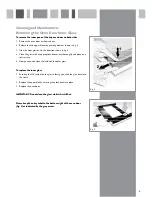
10
Installation
Important
If the oven is being installed into a built under oven housing unit ensure that the front rail at the top of the unit is not
installed as it could restrict ventilation.
Ensure that air can flow freely around the housing area. If the oven is being installed into a fully enclosed built-under oven
housing unit it may be necessary to cut a small slot in the top of the plinth fitted under the unit. Cut a section 400mm
wide and a minimum of 15mm high to allow air to pass under the unit. Alternatively cut a section 400 x450mm in the base
of the carcass as indicated.
Failure to allow adequate ventilation to the appliance may result in overheating or damage to adjacent units and could
invalidate the warranty.
This appliance is type X installation.
The walls of the kitchen units must be able to withstand temperatures of 75
o
C above ambient (typically this is between
90
o
C and 100
o
C).
When correctly installed ensure that there is a gap of 3mm minimum between the sides of the oven and adjacent
furniture doors.
Lift the oven carefully into position on the shelf, taking care NOT to lift it by the door handle. If you lower the oven door,
you will see 4 screw holes, 2 on each side of the oven. The oven should then be secured to the housing by fitting screws
into these holes. Remember the housing should not be free standing but be secured to the wall and/or adjacent fittings.
How to install your oven
You will need the following housing area fit your oven correctly.
The oven is designed to fit into a cabinet of 600mm
width. The oven can be built in or built under the kitchen
units, but you must ensure that it is properly ventilated.
In the diagram the built-in oven is ventilated by means of
a space at the top of the kitchen cabinet.
There are many other methods of ventilating your oven -
Consult a qualified engineer for advice.
fig. 6
Dimensions
Height (mm)
Width (mm)
Depth (mm)
Oven
594
598
499
Housing
575
560
560 (min)
400
560
560
560
450
57
5
57
5
100
560
450
499
598
594
558
573
23






























